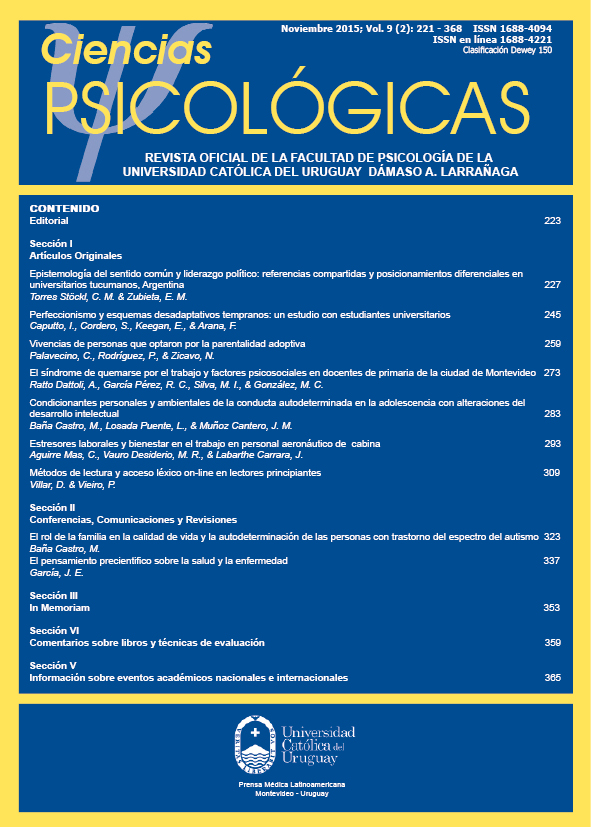READING METHODS AND ONLINE LEXICAL ACCESS IN BEGGINER READERS
DOI:
https://doi.org/10.22235/cp.v9i2.617Keywords:
lexical access, reading methods, reading acquisitionAbstract
The aim of this study was to analyze online lexical access in first-grade students according to the learning method used at school. To that end, we selected two groups of students depending on the learning method to read (global vs. synthetic - phonetic). We analyzed the responses of subjects based on verification rates (reading words) and time. We manipulated stimuli based on a set of criteria (degree of familiarity of the word, length and positional syllable frequency). Students who used overall method of decoding showed difficulties since their reading times in low familiarity words and low frequency positional syllabic were significantly higher. Students of the synthetic method proved more adept at decoding but their reading times were significantly higher in almost all parameters. These results confirm the idea that the method affects learning strategies used by students depending on the lexical and sublexical features of the word.Downloads
References
Alegria, J., Pignot, E., & Morais, J. (1982). Phonetic analysis of speech and memory codes in beginning readers. Memory y Cognition, 10(5), 451-456.
Alvarez C.J., Carreiras, M., & de Vega, M. (1992). Estudios estadísticos de la ortografía Castellana: (1) la frecuencia silábica. Cognitiva, 4, 75-105.
Ashby, J., & Martin, A. E. (2008). Prosodic phonological representations early in visual word recognition.Journal of Experimental Psychology: Human Perception and Performance, Vol 34(1), 224-236.
Cuetos, F. (1990). Psicología de la lectura. Madrid: Escuela Española.
Cuetos, F. & Suárez-Coalla, P. (2009). From grapheme to word in learning to read in Spanish. AppliedPsycholinguistics, 30, 583-601.
Domínguez, A. & Cuetos, F. (1992). Desarrollo de las habilidades de reconocimiento de palabras en niños con distinta competencia lectora. Cognitiva, 4, (2), 193-208.
Galera, F. (2009). La enseñanza de la lectura y la escritura: Teoría y Práctica. Granada: Grupo Editorial Universitario.
Gollan, T. H., Slattery, T. J., Goldenberg, D., Van Assche, E., Duyck, W., & Rayner, K. (2011) Frequency drives lexical access in reading but not in speaking: The frequency-lag hypothesis.Journal of Experimental Psychology: General, 140(2), 186-209.
Goswami, U. C., & Bryant, P. (1990). Phonological skills and learning to read. Psychology Press.
Guzmán, R. (1997). Métodos de lectura y acceso al léxico (Tesis doctoral). Universidad de La Laguna, España.
Hoien-Tengesdal, I. yHoien, T. (2012) The Reading Efficiency Model: An Extension of the Componential Model of Reading. Journal of Learning Disabilities, 45, 480-486.
Kewaza, S. y Welch, Myrtle I. (2013). Big Class Size Challenges: Teaching Reading in Primary Classes in Kampala, Uganda’s Central Municipality. Journal ofUS-China Education Review, 3, 283-296.
Morton, J. (1980). The logogen model and orthographic structure. In U. Frith (Ed.), Cognitive processes in spelling. London: Academic Dress.
Morton, J. & Paterson, K.E. (1980). A new attempt at an interpretation, or, an a attempt at a new interpretation. In M. Coltheart, K.E. Patterson & J.C. Marshall (Eds.). Deep dyslexia (pp. 91-118). London: Routledge & Keplan, Paul.
Patterson, K. & Shewell, C. (1987). Speak and spell: Dissociations and word-class effects. In M. Coltheart, G. Sartori, & R. Job (Eds.). The cognitive neuropsychology of language ( pp. 273-394). London: Erlbaum.
Perfetti, C. A., Beck, I., Bell, L. C., & Hughes, C. (1987). Phonemic knowledge and learning to read are reciprocal: A longitudinal study of first grade children. Merrill-Palmer Quarterly (1982-), 283-319.
Sowden, P. T. & Stevenson, J. (1994). Beginning reading strategies in children experiencing contrasting teaching methods. Reading and Writing, 6(2), 109-123.
Stanovich, K.E. (2000). Progress in Understanding Reading. New York: Guilford Press.
Vannorsdall, T.D., Maroof, D.A., Gordon, B. ySchretlen, D.J. (2012). Ideational fluency as a domain of human cognition.Neuropsychology, Vol 26(3), 400-405.
Venezky, R. (1978). Two approaches to reading assessment: A comparison of apples and oranges. Aspects of reading instruction. Berkeley, CA: McCutcheon.
Wang, Ch. & Inhoff, A.W. (2013).Extraction of linguistic information from successive words during reading: Evidence for spatially distributed lexical processing.Journal of Experimental Psychology: Human Perception and Performance, 39(3), 662-677.
















